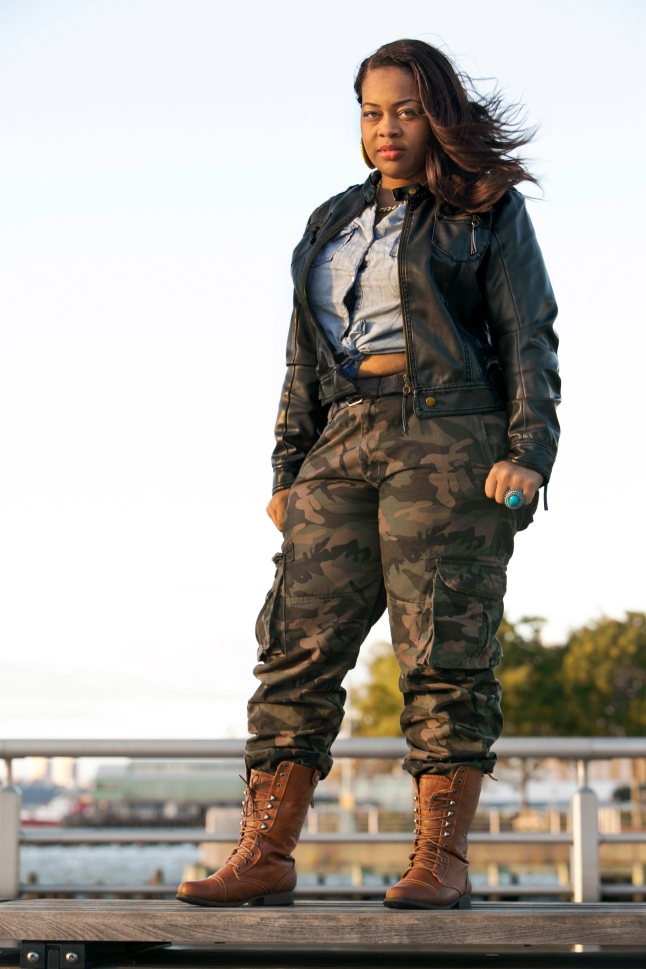Four Young African-American Women, Sexually Harassed on a New York Street, Fight Back in ‘Out in the Night,’ Kicking Off POV’s 28th Season on PBS on Monday, June 22, 2015
Labeled a Gang of “Killer Lesbians,” Renata Hill, Patreese Johnson, Venice Brown and Terrain Dandridge Tell Their Story For the First Time, Recalling Their Uphill Battle in the Courts of Law and Public Opinion
POV’s 28th season on PBS begins Monday, June 22 at 10 p.m. (check local listings) with blair dorosh-walther’s Out in the Night, which follows the lives of four African-American lesbians from Newark, N.J., as they face the charges and convictions for for defending themselves in an anti-LGBT attack.
In 2006, under the neon lights of a gay-friendly neighborhood in New York City, a group of African-American lesbians were violently threatened by a man on the street. The women fought back and were later charged with gang assault and attempted murder. The tabloids quickly dubbed them a gang of “Killer Lesbians” and a “Wolf Pack.” Three pleaded guilty to avoid a trial, but the remaining four — Renata, Patreese, Venice and Terrain — maintained their innocence. The award-winning Out in the Night examines the sensational case and the women’s uphill battle, revealing the role that race, gender identity and sexuality play in our criminal justice system.
Out in the Night opens with audio clips from police radio dispatches describing “officers fighting with gangs, Bloods and Crips” followed by a reference to “approximately five female blacks,” then to a “gentleman that was stabbed by . . . girls.” There were a number of inaccuracies in these dispatches, but the pictures they painted set the stage for the sensational story of four young women–Renata Hill, Patreese Johnson, Venice Brown and Terrain Dandridge–that followed.
The film marks the first time that the women have told their side of the story. Two women are the film’s primary focus: Renata, a single mother of a 5-year-old son, and Patreese, a petite 4-foot-11-inch femme-identified poet. As they and their friends strolled beneath the neon lights of the Village in 2006, they were confronted by 28-year-old Dwayne Buckle, who was selling DVDs. “Let me get some of that,” he said to Patreese, pointing below her waist. When she told him she was gay, he threatened to force the women “straight” through rape. He threw a lit cigarette, yanked out a handful of Venice’s hair and began to choke Renata. Thinking one of her friends was “about to die,” Patreese pulled a knife from her purse and stabbed him. Strangers jumped in to defend the women and the fight escalated. The entire incident, captured by security cameras, lasted four minutes. When it was over, everyone walked away.
The women were immediately arrested, even though the footage shows many people were involved in the altercation and the officers said the man’s wound appeared to be minor. The seven women were charged with gang assault, assault and attempted murder. Three pled guilty to avoid a trial and potentially lengthy prison time. Renata, Patreese, Venice and Terrain maintained their innocence and their right to self-defense.
A media frenzy followed. “The headline writers had a very good time,” says New York Post writer Laura Italiano about her paper’s “Attack of the Killer Lesbians” story. Other headlines included “Girls Gone Wilding” and “Man Is Stabbed in Attack After Admiring a Stranger.”
“I wanted to understand why this man was considered, in the mainstream news media, as a potential suitor and not a threat,” says filmmaker blair dorosh-walther. “Why weren’t these women seen as survivors of violent, homophobic harassment? And why were a group of friends with no criminal records, who were not a gang, being charged as a gang?”
“People kept hearing ‘gang assault,’” says attorney Lori Cohen who, with Susan Tipograph, defended Renata at trial, “and it brings up an image in your head that doesn’t really apply here. . . . You see [the man] in the surveillance tape. He clearly was coming at them in an aggressive manner.” But, explains New York Police Department arresting officer Christopher O’Hare, “By law if three or more people are involved in beating someone, it’s a gang assault.”

Out in the Night: A documentary film by blair dorosh-walther. Image of Venice Brown. Photo Credit: Lyric Cabral
Despite the man’s testimony at trial that the women came out of nowhere, that all he said was “hello” and that he was defenseless and terrified, Laura Italiano says, “Myself and other members of the press were getting a fuller picture of his views on the right of men to ogle women and shout out things as they walked by.”
In April 2007 the four women were found guilty. Two were sent to Bedford Hills Correctional Facility, a maximum security prison, and two were sent to Albion Correctional Facility, 48 miles from the Canadian border. Continue reading



